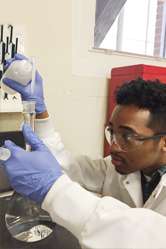Major: Chemical Engineering
“Aerosol Chemical Composition in the Mid-Atlantic Region: Assimilation with Aerosol LIDAR to Provide Insight into Aerosol Sources and Processes”

Extensive measurements of aerosol chemical composition are to be carried out at a near-coastal urban site in the Mid-Atlantic (Baltimore, MD). The measurements will include analysis of both organic components and inorganic ions (Na+, NH4+, K+, Ca2+, Mg2+, Cl-, NO3-, SO42-) sampled in near-real-time with a Particle-into-liquid sampler (PILS). The systems will be deployed to measure continuously on time scales of 10-20 minutes for weeks-to-months, and across multiple seasons. Elastic, Raman and Doppler light detection and ranging (LIDAR) measurements provide high resolution information on the altitude dependence of troposphere aerosols, water vapor, and wind. A primary motivation of the work is the coupling of detailed, time-resolved chemical composition measurements with the intensive and extensive aerosol parameters (e.g. attenuated backscatter, extinction, aerosol optical depth, Angstrom coefficient, etc.) from LIDAR profiles, satellites, and ground based PM2.5 instruments. This work will enable the examination of the effect of radiative forcing of aerosols in the Mid-Atlantic region as a function of air mass composition, hygroscopicity, and relative humidity (RH). An overall goal of the work is the characterization of aerosol properties under predominantly anthropogenic, biogenic, and marine influences. This will also include a seasonal analysis of the coupling and impacts of the boundary layer on aerosol chemical composition.
What research experiences have you had?
During summer 2014, I was sent to Colorado to represent UMBC in the fourth flight campaign of NASA’s DISCOVER-AQ mission (Deriving Information on Surface Conditions from Column and Vertically Resolved Observations Relevant to Air Quality). My job was to setup and maintain a system that remotely measures the chemical composition of particulate matter less than or equal to 2.5 microns (PM2.5). I also had the opportunity to explain our research to prospective high school students interested in atmospheric research.
During the fall 2014 semester, I have been analyzing the data from the summer campaign. The purpose of our research is to characterize aerosol properties as predominantly anthropogenic, biogenic, or marine.
How did you find the research opportunity?
I e-mailed Dr. Hennigan after reading about his research on his faculty page. He interviewed me in person and I started working in his lab shortly thereafter.
Who did you work with on this project?
I worked with several colleagues: principal investigators, Dr. Christopher Hennigan, Dr. Ruben Delgado, and Dr. Raymond Hoff, graduate student, Fabian Orozco and undergraduate student, Jessica Izumi.
Do you get course credit for this work? Paid? How much time do you put into it?
Yes, I received a credit through PRAC 98 during summer 2013 and I do get paid for this work. During the spring and fall semesters, I work about 13 hours per week. Outside of these semesters, I work about 35 to 40 hours per week.
What academic background did you have before you started?
Up to the sophomore chemical engineering curriculum completed.
How did you learn what you needed to know to be successful in this lab?
Dr. Hennigan is a great mentor. He guided me in the right direction, but did not do all the work for me. He allowed me to struggle through problems and allowed me to develop my own unique solutions. Because I had a major part in developing these solutions, I understood them very well.
What was the hardest part about your research?
After conducting data analysis, it is usually not clear where to go next. The results inherently provoke a lot of questions that seek to explain why. Then, there are logistics that those questions propagate: "Which question should I address first? How do I address it? How long will it take?" Fortunately, Dr. Hennigan is very knowledgeable on the topic, and he has always provided sufficient guidance in digestible amounts.
What was the most unexpected thing?
My problem solving skills were especially tested as my group did not have access to an abundant amount of lab supplies – we were in a trailer in a remote location on the side of a mountain! However, after collaborating closely with Dr. Hennigan and my colleagues, we were able to speedily automate an alternative solution within the same week.
How does this research experience relate to your work in other classes?
I have taken Dr. Hennigan’s class about air pollution. Part of the class discusses the sources of pollution. It is interesting to see that the data I analyze correlate well with his teachings. I am also currently taking a graduate level kinetics course. For my final project, I decided to use data from the DISCOVER-AQ mission to stochastically model tropospheric nitric acid evolution. It was convenient and somewhat comforting to have measured nitric acid data to validate (or refute) my model. The results also made me genuinely more curious on why it worked so well.
What is your advice to other students about getting involved in research?
First, read about the research a professor is doing. If it interests you, let him or her know that you are interested in participating.
You do not have to research something directly pertaining to your field. Base your search on topics that interest you. If you are unsure, talk to the professors for more information.
What are your career goals?
I would like to work in industry for a few years, then pursue a higher degree pertaining to either engineering management or environmental engineering. My decision will be based on my experience in industry.
What else are you involved in on campus?
I give free guitar lessons and collaborate with a lot of musicians on campus.
11/14/2014